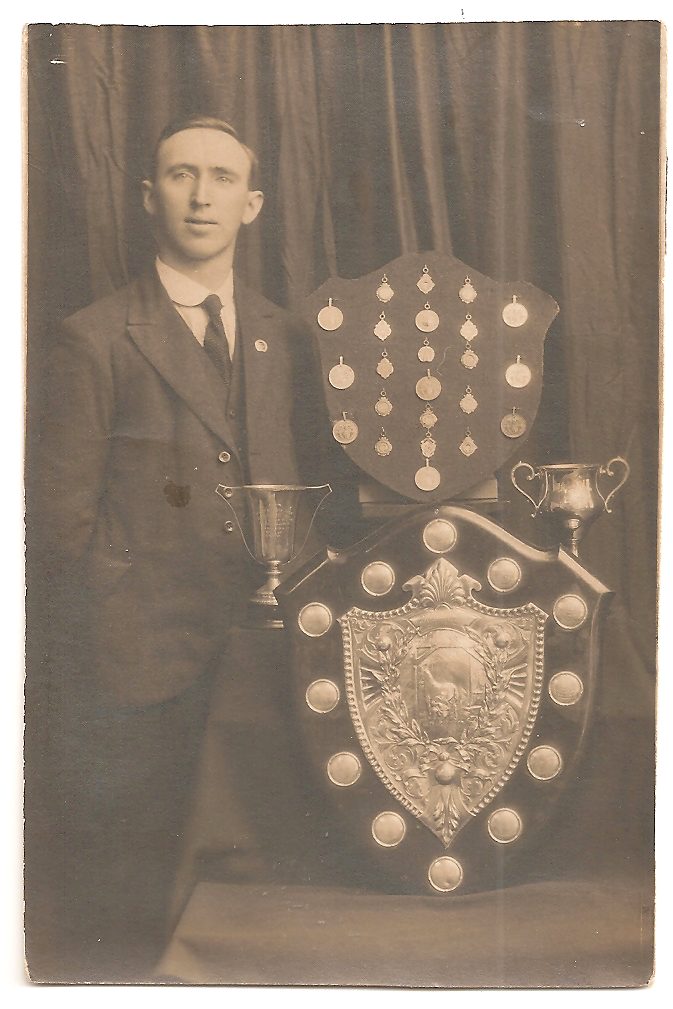Where did the Anvil First Ring for John Davies, Champion Farrier of Great Britain Five Times?

John Davies was born in Talog on 3 November 1891 to David and Anna Davies of Ffynnon-madog. He was one of eleven children born to them, six while they were living in the parish.
David and Anna were married at the non-conformist Tabernacle Baptist Chapel by the Rev. David Roberts of Bethania Chapel, Talog, on 12 November 1885.
Life for John was carefree until he went to school and he was able to wander with other children among the farms and along the banks of the river Cywyn, but he was always attracted to the smithy with its fire and the drama of shaping metal and watching horses being shod.
Home was just a short walk away and he would spend hours at the smithy. The blacksmith was a short and stout man, and John described him as being kind man, particularly to children, and he allowed John and others to ‘play’ at knocking on the anvil. Playing wasn’t enough for John and he soon began to learn the neccessary cadences required to succesfully shape metal.
So much so that he learnt to match the style of the smith, probably David Thomas, who took the opportunity of leaving him at the smithy while he walked across the road to the Castle Inn to ‘slake his thirst’. This earned John many pennies to spend at the shop, as it meant that David’s wife Mary would be content that work was being done. If she could not hear the sound of the anvil she would come across to the smithy and strike it, imitating a waiting customer and calling David back to work.
David told John’s father that because of his interest, unlike the other boys who came to the smithy, he might actually make a blacksmith which, even at such a young age, he had suggested as his ambition. Though he was cautioned that the trade required strength and commitment.
At age seven the family moved away to Llangain outside Carmarthen and he went to school until the age of about 12. But across the fields he could hear the sound of the two smithies at Brook village which he visited when he could. He confided there that it was his intention to be a blacksmith but was told that it was a hard trade to learn.
He spent four years working on a local farm, ‘to get his back up’ as his father said. He was then apprenticed to Henry Evans at Pantyrhin Forge just outside Llangain on the road to Carmarthen. His father put down the not inconsiderable sum at the time of £8 for the indenture, to be returned when John completed his apprenticeship.
After three “hard but happy years’’ and to the surprise and pleasure of both him and his father he received £10 back.
John then spent a year at Llanfynydd as an ‘improver’ where they also made and repaired farming tools and implements, using various grades of iron, not just cast iron which he had been used to. This experience he said was of great value to him in later years when there were fewer horses needing to be shod.
The turning point in his career was when he went to Carmarthen and worked at the Cambrian Forge in the centre of town near the cattle market. Owned by John Issaac, John desribed him as being not only a clever craftsman but also a good business man who taught him the way to run a forge.
It was here that John Isaac, noticing his skill and commitment, encouraged John to enter competitions. Taking part not only provided the challenge to develop skills but also confirm skills and attract business, promoting the forge as a centre of excellence.
John qualified first as a Registered Shoeing Smith [RSS] and later as an Associate of the Worshipful Company of Farriers, their highest award by examination, recognising him as a master farrier.
That John continued at Cambrian Forge is a credit to John Isaac owner of the forge. But it also shows that they got on well – evidenced that John was later able to purchase the business – and that he was recognised as being an asset to the business. Competent and well-liked.
His skills were widely recognised and it was later said of him that he ‘could make a lame horse trot.’
It brought him a very comfortable living and in the agricultural community ‘position and influence’. He was elected Secretary and later President of the Carmarthenshire Master Farriers Association.
John won over 100 competitions throughout England and Wales, including the prestigious Capewell Challenge Shield three times and in 1923 he brought the Champion Farrier of Great Britain Shield to Wales for the first time. Eventually five times.
He was always in demand as a judge, not only the ‘grand’ agricultural shows but also happy to support smaller shows and encourage those willing to learn ‘the arts and mysteries of the craft’.
John’s quiet demeanour hid a kind and generous personality who when encouraged in later years by his many grandchildren would often include funny stories of the happy, carefree times he spent as young boy in Talog, where he first heard the ring of the anvil.
John Davies, AFCL, Master Farrier, died at Glangwili Hospital on 27 August 1965. Enw da yw’r trysor gorau
In an extract from “How I became a Blacksmith”, some notes written by John Davies, he recalled an incident involving “Dafi Gof”, the Talog blacksmith.
Contributed in 2021 by Jeff and James John Herschel, David-Miles James and Johanna Kerslake. Four of his grandchildren.